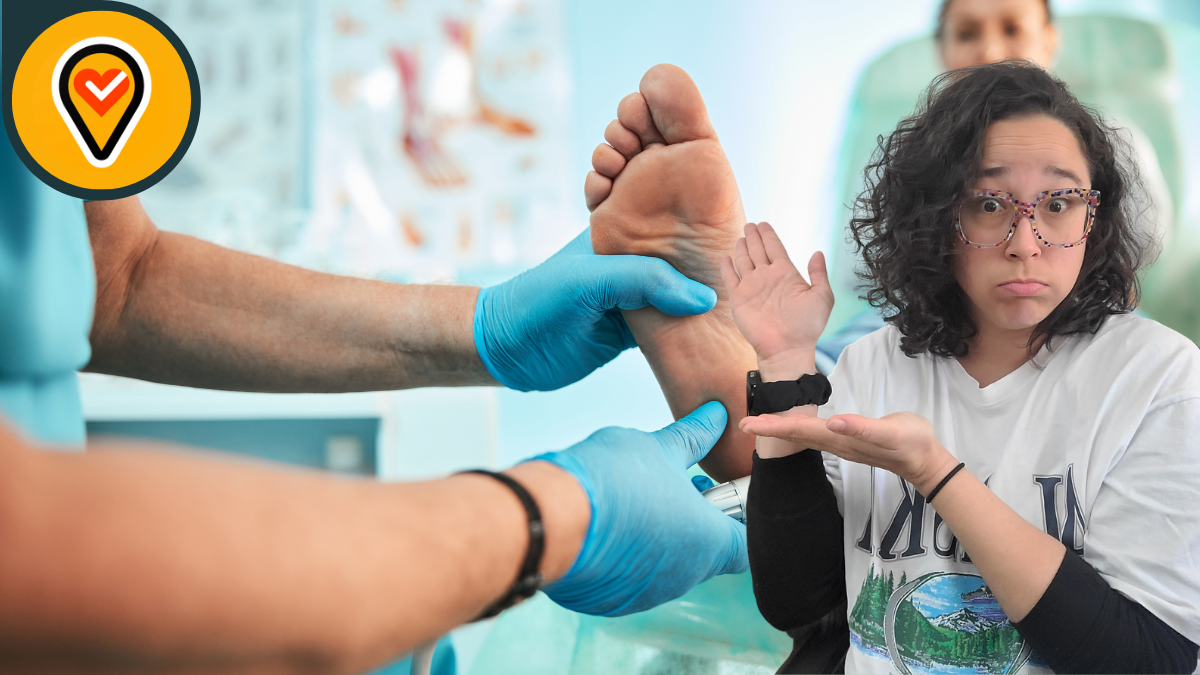
Do You Need a Podiatrist in Korea
Have you struggled to find a Podiatrist in Korea? That’s because it’s not a medical specialty in the Korean medical system. Our groups often get requests for a local podiatrist recommendation and it’s hard to explain how to find care when the specialty doesn’t exist. Therefore, we put this somewhat detailed post together so international residents living in South Korea can find the right specialist for their foot issues.
- About Podiatry Care in South Korea
- Why doesn’t Korea Have a Podiatry Specialization?
- About Foot Care in South Korea
- Medical Specialties Focused on Podiatry Issues
- Orthopedic Surgeon (정형외과, Jeonghyeong Oegwa)
- Dermatologist (피부과, Pibugwa)
- Vascular Surgeon (혈관외과, Hyeolgwan Oegwa)
- Endocrinologist (내분비내과, Naebunbi Naegwa)
- Physical Therapist (물리치료사, Mullichiryosa)
- Rheumatologist (류마티스내과, Ryu-matiseu Naegwa)
- Rehabilitation Medicine (재활의학과, Jaehwal Uihakgwa)
- Pediatrics (소아과, Soagwa) (For Children’s Foot Issues)
- Search Terms for Foot Issues on Naver
- More About Medical Specialties in South Korea
About Podiatry Care in South Korea
Korea does not have a separate field of podiatry, which is common in countries like the United States. Instead, patients with foot-related issues in Korea visit different specialists based on the type of foot problem they are experiencing. Here’s how foot care is handled in Korea:
Why doesn’t Korea Have a Podiatry Specialization?
Korea does not have a podiatry specialty largely due to differences in how medical fields are structured and the approach to healthcare specialization. Unlike countries such as the U.S., where podiatry is a standalone field focused exclusively on foot and ankle issues, Korea integrates foot care into broader medical specialties such as orthopedics, dermatology, internal medicine, and rehabilitation medicine.
Here are a few reasons why podiatry as a separate specialty hasn’t developed in Korea:
Integration into Existing Specialties:
In Korea, foot-related issues are managed within other established medical specialties. Orthopedic surgeons handle bone and joint problems, while dermatologists address skin and nail conditions. Endocrinologists oversee diabetes-related foot care, and physical therapists manage rehabilitation. Because these areas are already covered by multiple specialists, there hasn’t been a strong need to create a separate podiatry field.
Healthcare System Structure:
The Korean medical system emphasizes a generalist approach, where doctors often specialize in a broader range of conditions rather than focusing narrowly on a specific part of the body, like the feet. Foot issues are typically viewed as part of the larger musculoskeletal or dermatological system, so they are treated by specialists who manage a variety of related conditions, rather than developing a distinct podiatric discipline.
Cultural and Medical Priorities
The development of medical specialties is influenced by cultural and medical priorities. In Korea, there has been more emphasis on fields like internal medicine, surgery, and traditional Korean medicine (which also plays a role in managing chronic pain and other foot-related issues through acupuncture). The focus has been on comprehensive care through these specialties rather than creating niche specialties like podiatry.
Demand for Specialized Care
The demand for podiatric services in Korea may not have been as strong as in other countries where foot and ankle issues, particularly related to chronic conditions like diabetes or sports injuries, have driven the need for a focused specialty. In Korea, these issues are typically managed within existing medical frameworks, and patients usually seek care for specific symptoms rather than needing a podiatrist as their first point of contact.
About Foot Care in South Korea
In Korea, people generally visit hospitals or clinics that specialize in different types of foot-related issues rather than a dedicated podiatrist. Orthopedic hospitals (정형외과 병원) often handle many of the structural issues related to feet, such as fractures or deformities, and they may offer non-surgical treatments like custom-made orthopedic shoes (맞춤형 신발).
There is also an emphasis on preventive care, especially for conditions like diabetic foot ulcers, which are monitored closely by endocrinologists or internal medicine specialists. Large hospitals like Seoul National University Hospital or Asan Medical Center have comprehensive diabetes centers that offer specialized foot care.
Traditional Korean Medicine (한의학) also plays a role in foot care, particularly for issues related to chronic pain or circulation. Acupuncture and herbal treatments may be used as part of an integrated approach to managing foot health.
Many Koreans also practice regular self-care for their feet, including visits to foot spas (족욕탕, Jogyoktang) and nail salons, which are popular for addressing minor issues like calluses or ingrown toenails.
Medical Specialties Focused on Podiatry Issues
The following section provides more specific insight into the different Korean medical specialists who treat aspects of podiatry-related illnesses.
Orthopedic Surgeon (정형외과, Jeonghyeong Oegwa)
- Common Conditions: Bone, joint, and ligament issues in the foot and ankle.
- Symptoms: Foot or ankle pain, fractures, sprains, bunions (건막류, Geonmakryu), flat feet (평발, Pyeongbal), arthritis (관절염, Gwanjeollyeom), or deformities.
- Treatment: Surgical interventions, physical therapy, and non-surgical approaches like braces, orthopedic shoes, and medications.
- When to Visit: If you have structural problems like a broken bone, persistent joint pain, or any deformities in your foot, you should visit an orthopedic surgeon.
Dermatologist (피부과, Pibugwa)
- Common Conditions: Skin, nail, and soft tissue problems.
- Symptoms: Athlete’s foot (무좀, Mujom), nail fungus (발톱 곰팡이, Baltob Gompangi), warts, corns, blisters, or ingrown toenails (내성 발톱, Naeseong Baltob).
- Treatment: Medications (topical or oral), laser treatments, and minor procedures to treat skin and nail issues.
- When to Visit: If your foot issue is related to skin or nail health, a dermatologist is the specialist to see.
Vascular Surgeon (혈관외과, Hyeolgwan Oegwa)
- Common Conditions: Circulatory issues in the feet, such as peripheral artery disease (PAD) or varicose veins.
- Symptoms: Swelling, poor blood circulation, discoloration of the feet, or varicose veins (정맥류, Jeongmaekryu).
- Treatment: Surgical interventions, medications to improve circulation, and lifestyle adjustments.
- When to Visit: If you experience poor blood flow or persistent swelling in your feet.
Endocrinologist (내분비내과, Naebunbi Naegwa)
- Common Conditions: Foot complications from diabetes, such as diabetic neuropathy.
- Symptoms: Numbness, tingling, ulcers, or sores that won’t heal due to diabetes (당뇨발, Dangnyobal).
- Treatment: Diabetic foot care, blood sugar management, and wound care.
- When to Visit: Diabetic patients with foot-related issues should see an endocrinologist for a comprehensive care plan.
Physical Therapist (물리치료사, Mullichiryosa)
- Common Conditions: Rehabilitation for injuries like sprains, strains, or post-surgical recovery.
- Symptoms: Limited range of motion, weakness, or pain during movement.
- Treatment: Exercises, massages, and other therapies aimed at improving mobility and strength.
- When to Visit: If you need rehabilitation for foot or ankle injuries.
Rheumatologist (류마티스내과, Ryu-matiseu Naegwa)
- Common Conditions: Inflammatory conditions like gout (통풍, Tongpung) or rheumatoid arthritis (류마티스 관절염, Ryumatiseu Gwanjeollyeom) affecting the feet.
- Symptoms: Joint pain, swelling, or stiffness in the toes or other parts of the foot.
- Treatment: Medications (anti-inflammatory, immune-suppressing), lifestyle changes, and physical therapy.
- When to Visit: If you have inflammatory joint conditions that affect your feet.
Rehabilitation Medicine (재활의학과, Jaehwal Uihakgwa)
- Common Conditions: Chronic foot pain, nerve damage, or post-surgery recovery.
- Symptoms: Difficulty walking, chronic pain, or reduced foot function after an injury.
- Treatment: Long-term rehabilitation programs, use of orthotics, and other assistive devices.
- When to Visit: For long-term management of foot problems, especially if mobility is impacted.
Pediatrics (소아과, Soagwa) (For Children’s Foot Issues)
- Common Conditions: Growth-related issues like flat feet in children or congenital deformities.
- Symptoms: Unusual walking patterns, foot deformities, or pain while walking.
- Treatment: Orthotic devices, physical therapy, or surgery in severe cases.
- When to Visit: If children have any abnormalities in foot development.
Search Terms for Foot Issues on Naver
Now that you have a more complete understanding of foot care in Korea, the following search terms may help you find the support you need.
Orthopedic Surgeon (정형외과, Jeonghyeong Oegwa)
- 발 뼈 통증 (Bal Ppyeo Tongjeung) – Foot bone pain
- 발목 통증 (Balbok Tongjeung) – Ankle pain
- 발 골절 (Bal Goljeol) – Foot fracture
- 족저근막염 (Jogjeo Geunmangyeom) – Plantar fasciitis
Dermatologist (피부과, Pibugwa)
- 발톱 곰팡이 (Baltob Gompangi) – Toenail fungus
- 무좀 치료 (Mujom Chiryosil) – Athlete’s foot treatment
- 발 피부 질환 (Bal Pibu Jilhan) – Foot skin condition
- 내성 발톱 (Naeseong Baltob) – Ingrown toenail
Endocrinologist (내분비내과, Naebunbi Naegwa)
- 당뇨발 (Dangnyobal) – Diabetic foot
- 당뇨병 발 관리 (Dangnyobyeong Bal Gwalli) – Diabetic foot care
- 당뇨병 신경병증 (Dangnyobyeong Singyeongbyeongjeung) – Diabetic neuropathy
Physical Therapist (물리치료사, Mullichiryosa)
- 발 재활 치료 (Bal Jaehwal Chiryosil) – Foot rehabilitation
- 발목 재활 (Balbok Jaehwal) – Ankle rehabilitation
- 발 통증 재활 (Bal Tongjeung Jaehwal) – Foot pain rehabilitation
These search terms can help you find relevant specialists or clinics for various foot-related issues in Korea, ensuring that even without a dedicated podiatrist, you can still get the care you need.
Searching in English on Google
If you search in English on Google you will find hospitals in Seoul, South Korea offering podiatry services to foreigners. This is because it’s good marketing to frame their services using terms English speakers understand.
However, once you leave major cities, this understanding of podiatry may quickly vanish. It’s important to understand that international residents living in South Korea want to find care closer to home. Having a full picture of how the health care system in Korea is conceptualized helps decrease misunderstandings and improves access to services.
More About Medical Specialties in South Korea
Of course, learning about finding a Podiatrist in South Korea is only the tip of the medical information iceberg. Learn more about medical specialties in the following blog posts.

Founded in 2015, the South of Seoul team consists of volunteers on three continents working together to support English-speaking people traveling or living in South Korea. South of Seoul volunteers work with organizations and individuals across South Korea to improve equitable access to information across South Korea. Much of South of Seoul’s information focuses on Pyeongtaek, Gyeonggi-do, South Korea.
Blogs published under the authorship of “South of Seoul” include blogs compiled by multiple volunteers to improve access to standardized information unrelated to individualized personal experiences.






